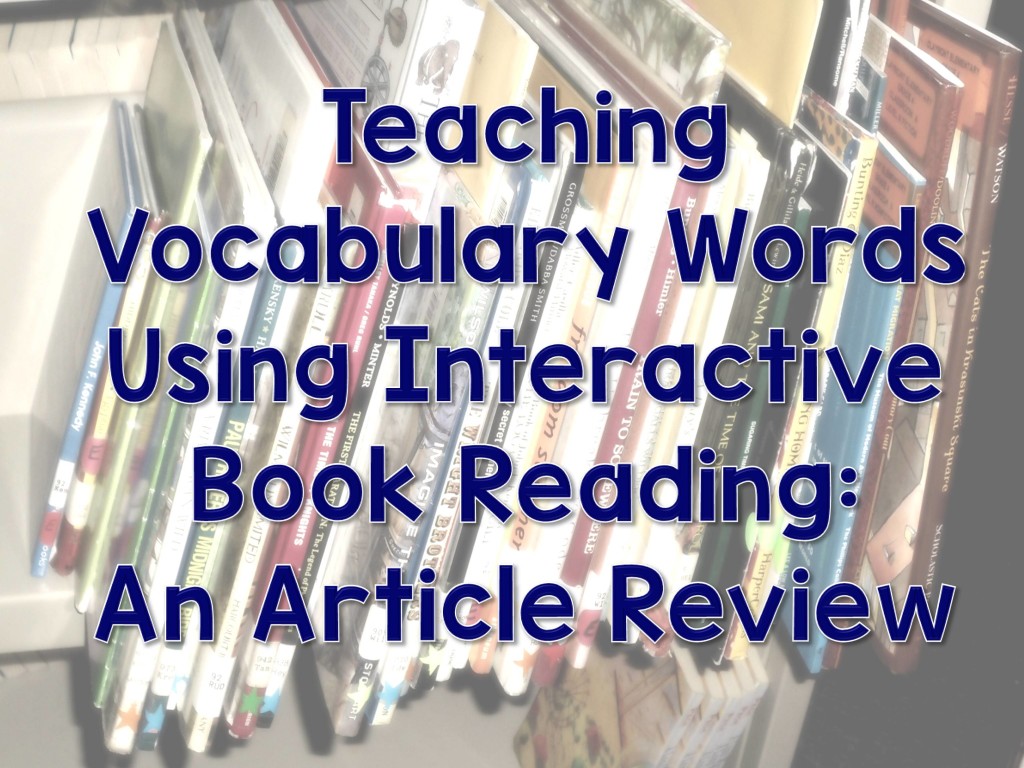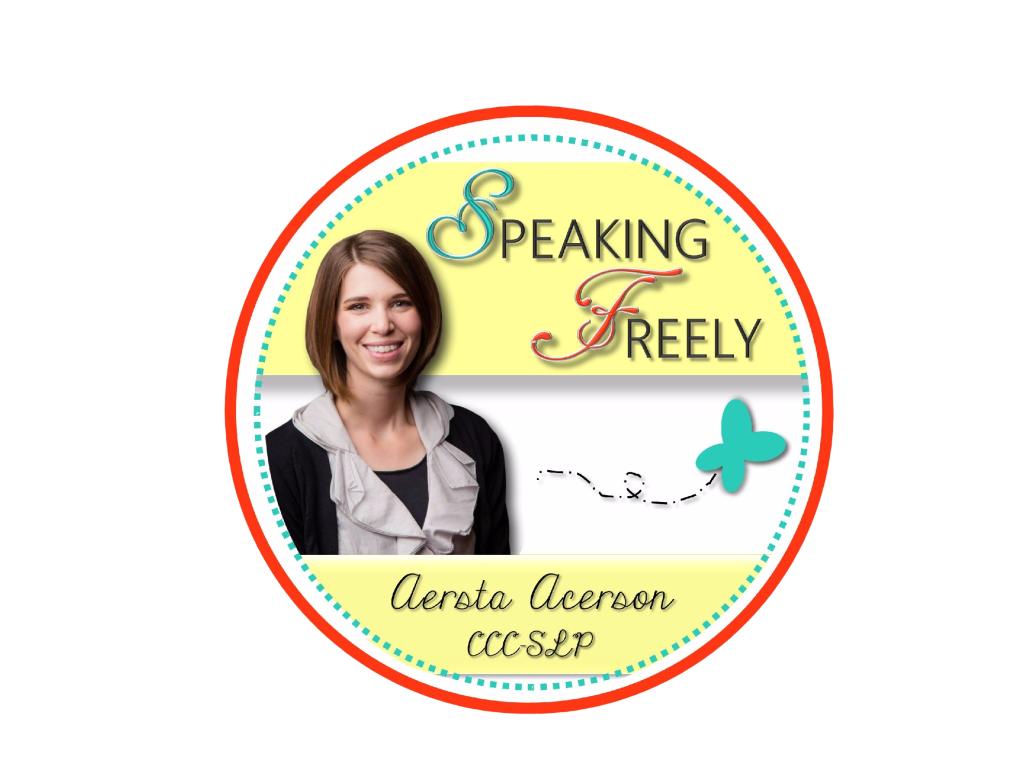Teaching Vocabulary Words Using Interactive Book Reading [Guest Post]
Today I’m bringing you a guest post from Aersta Acerson who blogs at Speaking Freely SLP!

Hello! My name is Aersta Acerson, and I’m so excited and honored for the opportunity to be guest blogging today with Teach Speech 365! This blog is always filled with amazing ideas, and I’m excited to add to the content today.
First, I’d like to tell you a little bit about myself. Obviously, I’m an SLP. 🙂 I’ve had my CCC for four years now, and I can’t even believe it’s been that long! I’ve worked in both the public school system and I’ve owned my own private practice, and I fully enjoy both settings. I love working with PK and elementary age children. My favorite therapy targets are phonological processes and language skills, especially vocabulary. I am wife to an amazing man, and mother to two beautiful little girls. I love sushi, reading, the beach, and spending time with family and friends. I own the TPT store Speaking Freely SLP. If any of you are familiar with my products, you’re probably aware that I’m highly passionate about data collection and obtaining thorough and accurate assessments of our client’s strengths and weaknesses.
I’m also highly passionate about EBP, and that’s what I’d like to focus the topic of this post on today. I’m going to share a summary and my thoughts on a fairly recent article published in the November 2015 issue of the ASHA Perspectives 1: Language Learning and Education. I took the plunge this year and decided to become a SIG member, and I’m SO glad I did. I love the instant access to all the great content contained in the Perspectives journals. The article I want to discuss today is called Teaching New Words to Children with Specific Language Impairment Using Interactive Book Reading. As I mentioned, I LOVE teaching vocabulary because I feel like it’s one of the areas where we can really make a difference as SLPs. Our students struggle so much in this area, and we’re often the only ones who really understand the underlying deficit, yet we have relatively little time with our students to address it.
So, obviously, I LOVE vocabulary and I think it’s incredibly important, but…that doesn’t mean I think it’s easy to teach! Quite the contrary, it can be a very difficult thing to teach, so I was super excited to see this study in the Perspective. In short, this study provides a detailed method of teaching vocabulary using children’s literature.
This study aimed to determine whether or not specific, intensive vocabulary instruction would improve the vocabulary in typically developing Kindergarteners. A group of Kindergarteners were divided into two groups: the treatment group and the control group. In the control group, a therapist simply read the chosen stories to the students without providing specific vocabulary instruction. In the treatment group, the same stories were read to the students, but six words were specifically targeted and taught during treatment. Ten commercially-available, engaging children’s books were chosen for this study. Six tier-two vocabulary words were then selected from each book. Throughout the session, the words were taught in four different ways: an explicit definition, direct text from the book, a context sentence that included the word, and a synonym. The treatment sessions were 15-20 minutes long and were divided into three sections: pre-book reading, book reading, and post-book reading. In the pre-book reading section, the therapist introduced the words that the students would hear in the book. The therapist showed the students picture cards of the words that were meant to show the definition of the word, and provided the definition of the word. During the book reading section of the session, the therapist read the book. After a sentence with a target word was read, the clinician would pause and provide a synonym for the word. The study gives the following example: They had no rides to share, no tug-of-war to play, no one to scratch behind their ears or ruffle their feathers. The clinician would then say, “Ruffle means to disturb.” Finally, during the post-reading section, the clinician would again review the target words, but this time, the words were provided within the context of a sentence that explained the definition. A picture card was included that depicted the sentence, and the definition was given one last time. This set-up allows for six exposures to each of the six target vocabulary words. According to research, children with SLI need approximately 36 exposures in order to learn a new vocabulary word. In order to accomplish this for each target word, each book was repeated six times over a series of six sessions.
Unfortunately, this study is still in preliminary stages, so there are no results to report yet, but we already know that students with language impairments benefit from direct vocabulary instruction, and we also know that using tier-two vocabulary words is best practice, so I think it’s safe to say we can confidently begin using this approach in therapy. The thing I really love about the study is that it provides a practical way to teach tier-two vocabulary words with enough exposures so that the student will actually learn and retain the words. In my opinion, retention is the most difficult part about vocabulary instruction. I’ve always struggled with how to teach vocabulary in a way that will generalize, but still teach enough words to make it worth my students’ time. Another great thing about this study is that the team conducting this study has provided the list of books along with the targeted vocabulary words that they used in the study. THIS MEANS THE WORK IS MOSTLY DONE FOR YOU! How great is that?! Here’s the link for you to check it out:
https://wordlearning.drupal.ku.edu/appendix-master-treatment-word-list
And that’s it! It’s a very straight forward approach, which is another thing I love about it. It’s very easy to implement in your own therapy room, and it’s very easy to repeat with any of your favorite children’s books. I sincerely hope you’ve found this post helpful and something that you can implement in therapy this week. If you feel so inclined, please click the following links to follow my Facebook page and TPT store. I’d love to hear how this approach works for you in your therapy room!
https://www.teacherspayteachers.com/Store/Speaking-Freely-Slp
https://www.facebook.com/speakingfreelyslp/

Aersta Acerson, CCC-SLP
Speaking Freely SLP
Reference:
Voelmle, K & Storkel, H. (2015). Teaching New Words to Children With Specific Language Impairment Using Interactive Book Reading. Perspectives on Language Learning and Education, 22(4), 131-137.

Thanks so much for sharing this! Even with the best of intentions, I find it hard to keep up with all of the journal articles, so I love your synopsis of this great EBP.